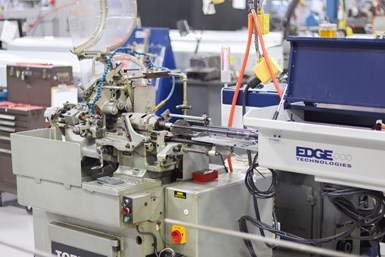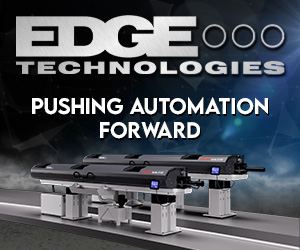Modern Bar Feeds Bring New Life to Automatic Swiss Lathes
Sponsored ContentCam-actuated Swiss lathes are still the fastest way to process many parts. By adding modern bar feeders, this shop has dramatically improved their utilization with the ability to work unattended, even in a lights-out environment.
Share
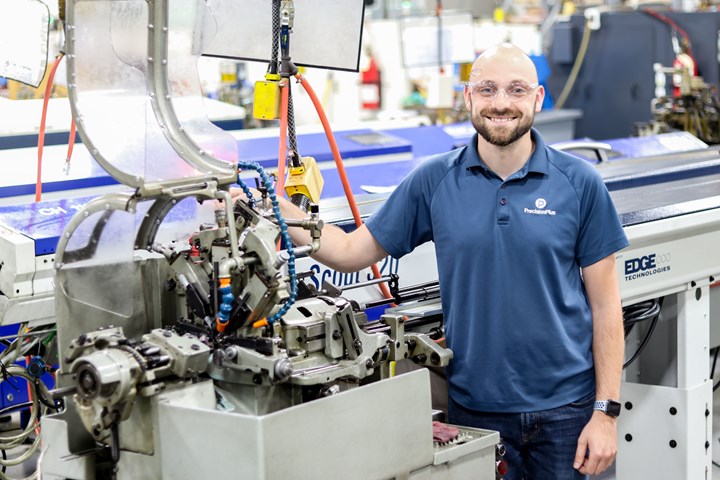
PrecisionPlus VP of Engineering, Mike P. Reader, with one of the company’s cam-actuated Swiss lathes.
Precision Plus is not your typical machine shop. Founded as a cam-type Swiss screw machine shop 40 years ago, Precision Plus has transformed into the modern part supplier it is today, with an array of state-of-the-art machining equipment. Just in the last few years, Precision Plus has spent some $3 million in precision CNC machines alone.
While still specializing in Swiss-type work, Precision Plus manufactures small parts with large length-to-diameter ratios, though these days with increasingly complicated geometries and high-quality requirements. A large amount of the high-volume work continues to produced on Tornos cam-actuated lathes. By combining the inherently efficient lathes with material handling automation, Precision Plus has figured out how to transform traditional technology to reach higher levels of efficiency with the ability to run mechanical machines in a lights-out environment.
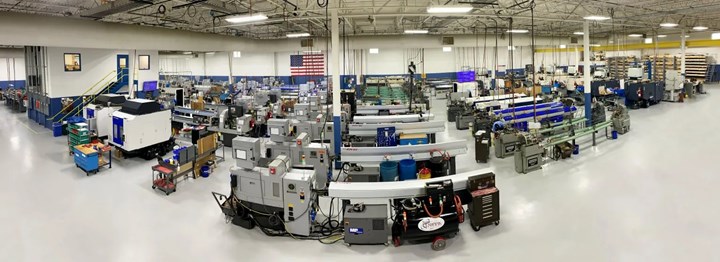
Precision Plus runs 33 CNC Swiss lathes, 9 CNC turn/mill centers, and 30 cam-actuated Swiss lathes.
The Right Machine for the Job
Today Precision Plus has 33 CNC Swiss lathes including Stars and Tsugamis, as well as nine CNC Miyano turn/mill centers. This equipment offers wide capability and flexibility to process short and medium-run work. But a number of high-volume jobs run on their bank of 30 Tornos cam-actuated machines with some updated with modern magazine-type bar feeds from EDGE Technologies. This method couples the inherent efficiency and reliability of a cam-actuated lathe with a substantial reduction in the labor required to run it.
The cam-actuated Swiss lathes have the lowest operating costs and can often yield the best return per square foot. Click image to view full size.
VP of Engineering, Mike Reader offers a quite simple and practical reason why they still use Tornos cam-actuated machines. “For small cylindrical parts with higher annual volumes, the Swiss cam machines are very economical,” he says. “The fleet of mechanically driven Swiss-type lathes have the lowest operating costs and can often yield the best return per square foot compared to any Swiss CNC. In the right application, certain parts can be machined significantly faster.
How much faster? “We have one part that would take eight seconds per piece on a Swiss CNC,” Reader says. “On the cam machine, it takes three seconds.”
While faster cycle times are obviously important, the cost advantage diminishes quickly if the machine sits idle waiting for an operator to manually load every bar. This is where material handling automation comes in.
Keeping Machines Running
In the old days, Swiss cam machines had a bar tube – descriptively referred to as a “rattle trap” – that supported the bar as it was pushed into the lathe. With short cycle time parts that could require that a new bar had to be manually loaded every ten minutes or so. Not only does that demand constant attendant labor, it also means nothing is being produced when the lathe needs stock. That’s why Precision Plus started retrofitting their cam machines with modern bar feeds in the early 2000s.
The new installations are now getting Scout 320 bar feeds from EDGE Technologies. Able to accommodate round, square or hex bar stock up to 12 feet in length and 3-20 mm in diameter, these bar feeds are particularly well suited to the application.
Because the EDGE Scout 320 magazine can hold up to 40 bars at a time, it enables long periods of unattended machining.
While bar feeds today are designed for CNC machines, Precision Plus was able to adapt the Scout to Tornos cam machines with the technical support of EDGE Technologies. Not any bar feed can be adapted to a sliding headstock machine, but that’s what the Scout is designed for. Standard on the Scout 320, the synchronization device for Swiss-style lathes electro-magnetically links the lathe's headstock Z-axis travel to the bar feeder's pusher. This ensures synchronous movement and no connection loss between bar stock and collet pusher.
Because the magazine can hold up to 40 bars at a time, it enables long periods of unattended machining. Precision Plus runs two 8-hour shifts per day. Reader says they check on and load the feeders at the beginning of each shift and then run with little attention required. At the end of the 2nd shift they are loaded again and run lights out until morning.
Skilled and Talented People
Running mechanical and CNC equipment in the same shop is no easy task in part because the skills required are so different. As Director of Education, Stefan Brusky puts it, “The advantages of mechanical machines are the lower cost of running them, smaller footprint, and lower capital cost. For the right part this can be an incredibly efficient process. The disadvantage is that the tooling and engineering are more difficult. You need to make a set of cams for each part, and executing a simple feed change is much more involved than editing a CNC program.”
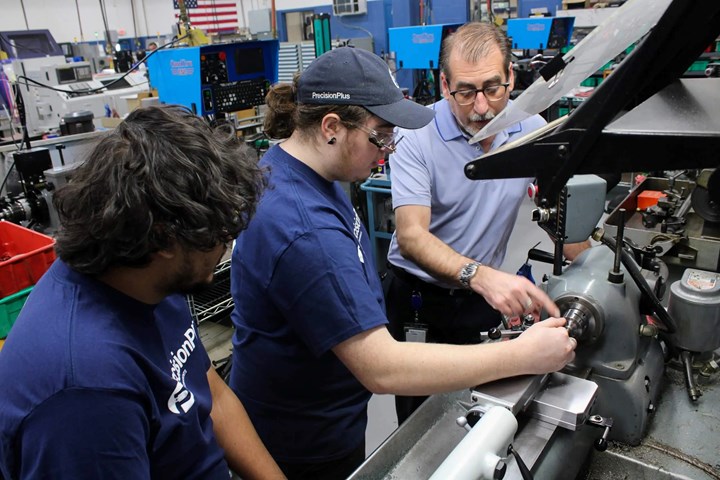
Precision Plus places great emphasis on training their own people in operation and maintenance of its equipment.
Finding people skilled in CNC is hard enough and for Swiss cam machines it’s nearly impossible. That’s why Precision Plus places great emphasis on training their own people in operation and maintenance of this specific set of equipment. As Swiss cam vendors became scarcer, Precision Plus brought this capability in-house.
Integrating mechanical machines with automatic bar feeders was a similar scenario. Precision Plus has actually been doing this since the early 2000s. Since there wasn’t really a bar feeder readily designed for this purpose they had to manage much of the integrations themselves. Matt Dowell, a young next generation manufacturing engineer at Precision Plus, has more recently executed a number of these integrations. He says, “Initially we were rewiring the machines and using old school relays (9 on each machine) for inputs and outputs to the bar feed. Now we use off-the-shelf PLCs,” which Dowell can program in house to integrate a specific bar feeder and lathe.
Having the electrical skills to do this is only part of the challenge; it also requires a keen understanding of how cam machines work. Dowell says being able to draw on the knowledge of experienced cam machine operators was critical to accomplishing the task.
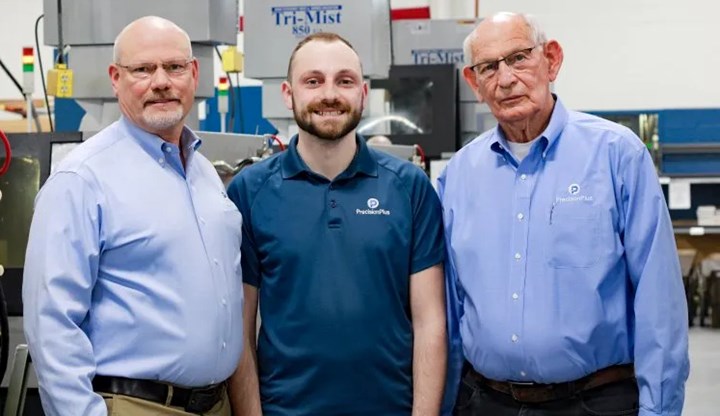
Three generations of leadership at PrecisionPlus. From left, president Mike P. Reader; VP of engineering Mike J. Reader; and former president Phil Reader.
Though impressive, this is not an isolated experience at Precision Plus. “We have subject matter experts (SMEs) for all our equipment,” says Reader, and those people function as a resource to anyone who needs their help. The organization continually invests in regular on-site training programs while also supporting a youth apprentice program since 2011.
Most shops talk about, or complain about, the need for skilled workers. Precision Plus has a larger view. “We look at everything as a challenge,” says Reader, “and there are usually multiple ways to solve a problem. We need people who are skilled, talented, and smart to work in this environment.” And they provide support for those people to reach their potential.
Precision Plus is also paying it forward in their community by supporting countless manufacturing engagement and outreach programs in southeastern Wisconsin, such as the Reader Precision Manufacturing (RPM) Center, at Gateway Technical College’s Elkhorn Campus. Precision Plus puts an emphasis on educating local, state, and national stakeholders on all things manufacturing: the importance of career opportunities, workforce development initiatives, and pertinent legislative issues. They are a leader in educating the next generation on opportunities in today’s landscape of high-tech manufacturing careers.
There are few cases you’ll find where a shop has done such an effective job of mixing traditional and new state-of-the-art technology. The key is having a keen understanding of how to find the best method, old or new, and augmenting that technology with the right level of automation to reach its full potential.
Please visit the PrecisionPlus website for more information on their capabilities. Please visit the EDGE Technologies website for more information on their bar feeds.
